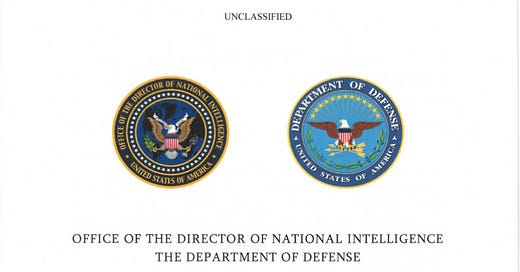I have nine primary takeaways from the most recent report:
The report states that none of the 291 cases considered were “positively attributable” to foreign adversaries. This is rather stunning. One cannot help but wonder about the numerous Navy cases involving brightly lit aerial objects that have been following U.S. Navy ships off the coast of California. Although those incidents were from an earlier time period, I believe they have continued and I do not believe an explanation has been found for these perplexing cases. This consistent lack of evidence connecting any UAP cases to foreign nations strengthens the ET hypothesis for the small number of unsolved cases involving extreme velocities and/or morphologies.
The report mentions 274 new reports in the last 8 months, suggesting a rate of over 30 reports per month / 360+ reports per year.
The reference to a “strong but shifting collection bias” in “restricted military airspace” is not surprising given the greater presence of monitoring sensors in those areas. This leaves unanswered the question as to whether U.S. training areas are being targeted and are areas of especially high activity. This claim also seems a bit odd since the UAP “hotspots” map shows very high levels of activity in the Middle East and the Sea of Japan and along the Chinese coast.
No new near mid-air collisions were reported. (A change from 11 previous near mid-air collisions from 2004-2021).
Some progress was noted in “sensor placement and calibration” and in employing “..more sensors specifically tailored for UAP detection.” This is highly encouraging to the extent the change is meaningful and extensive.
A high percentage of cases lack sufficient data to identify or resolve.
Only one maritime case and no UAP space cases were reported, although the report notes improving coordination with the Space Command.
There is no mention of the stunning earlier reporting from the Senate hearing with AARO witnesses indicating that some UAP emit radio signals in the 1-3 and 8-12 GHz band. Nor was there mention again of UAP intermittently emitting radar signals in the ‘X-Band’ (7.0–11.2 GHz).
AARO succeeded in getting its public website established.
Summary:
Overall, there seems to be steady progress in instituting UAP collection and reporting procedures. There also appears to be progress in adjusting sensors to better collect UAP data and in developing dedicated UAP sensors. Dr. Kirkpatrick seems to have instituted a disciplined process for collecting and evaluating UAP reports.
Many questions of course remain:
How effectively is AARO able to obtain access to compartmented UAP data from different organizations such as CIA and NORAD?
Why is it that AARO coordinated its latest report with SPACECOM, but not NORAD or CIA?
Is UAP data from NORAD’s giant Solid-State Phased Array Radars (SSPAR) reaching AARO? If not, why not? If so, what does that data look like? Are these mighty radars failing to detect the UAP reported by pilots off both the East and West coasts of the U.S. and if so why? What about other systems such as the Infrasound Monitoring Network or the Ground-Based Electro-Optical Deep Space Surveillance System (GEODSS)?
The U.S. engaged and shot down three UAP within days of the Chinese spy-balloon shoot-down on February 4, 2023 . There were also a flurry of reports of similar detections across the world around that time. Why have there been no further reported engagements of UAP by the U.S. Air Force over the U.S. homeland? Was there truly an unusual spike in activity in the days following the first shoot-down of South Carolina, or did we only bother with intercepts for those days immediately following the shoot-down before quickly relapsing to the policy of ignoring such intrusions all together?
Have we stopped detecting UAP with radio and radar emissions or have AARO and the DNI merely stopped reporting this activity?
How many times have U.S. fighter aircraft been launched to intercept UAP and in how many cases were the intercepts successful? This vital information would be of great value in helping Congress assess the effectiveness of U.S. air defenses.
Is the “UAP Science Plan” that has been developed classified? If so, is there any value to releasing an unclassified version to the scientific community? If not, why has it not already been shared?




